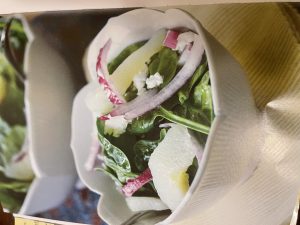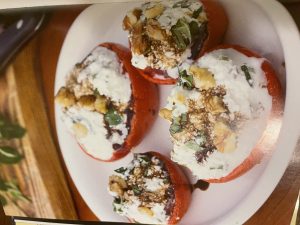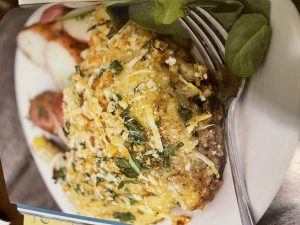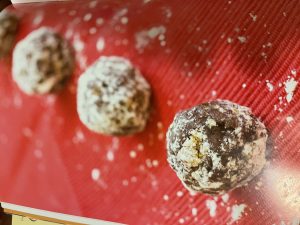This is a specialty cookbook since it has “Mennonite Men” in the title. It is about the recipes used by a Mennonite church leader named Willard Roth. It is centered around the values of the Mennonite religion. Something very indicative of this is the statement, “God is the source of all my life; God is the source of my food” (Roth, 2015, p. 307). This cookbook is also a compilation of different foods and dishes, such as: appetizers, soups, salads, poultry and seafood, breads, beverages, cakes, cookies, and pies. After looking through the table of contents and the entire cookbook and seeing the plethora of different recipes that the cookbook has to offer, it was evident that this cookbook is a compilation cookbook as well.

The author of the cookbook is Willard Roth. Willard Roth is a Mennonite church leader, a journalist, and a cook. He grew up on an Iowa farm and was inspired by his mother’s and grandmother’s recipes. In addition, “other recipes are inspired by the monasteries he’s visited in Ireland and England. There are recipes of the food he’s eaten in Ghana, Jamaica, Cyprus, the Netherlands, India, and Nepal.” (Roth, 2015). In terms of his background, Willard earned his Associate of Arts from Hesston college in 1953. He then earned his Bachelor’s degree from the University of Iowa in 1955, eventually followed by “Master of Divinity, Associate Mennonite Biblical Seminary, Elkhart, 1971” (prabook.com). In terms of his career, Willard served in several different positions throughout different Mennonite churches, such as: communications director, youth publications editor, international editor, and pastor of Southside Mennonite Church.

The cookbook was published in 2015. This tells us that some of these recipes could be fairly new, while others are old family recipes that have been passed down for generations. Based on what Willard wrote in terms of what motivated these recipes, they largely come from his past experiences with food, whether that be from within the family or derived from places he has traveled to, such as Jamaica and Nepal.
The intended audience for this cookbook is the average middle-class American household. The diversity of recipes in this cookbook are certainly fitting to many other cultures and countries as well. Their skill level does not have to be very high since each recipe comes with a detailed list of ingredients and instructions. It also lists how many servings each recipe makes as well as the preparation and baking time required. For instance, for a dish called “Parmesan-stuffed Mushrooms”, one item on the list of directions stated, “Spoon cheese mixture into caps; sprinkle with extra Parmesan.” (Roth, 2015, p. 9) This is a simple, but effective sentence that tells the “cook” exactly what to do and how to prepare throughout the process. Being a beginner at cooking, I even feel confident that I could follow the well-laid-out instructions and successfully prepare a good amount of these recipes with little to no assistance.

The ingredients found within this cookbook can largely be located in supermarkets in the United States. What this says about social class and access to ingredients is that the middle class or above is required to have access to all of these ingredients. Also, living in an urban area vs. a rural area would allow for easier access. In terms of gender and sexual orientation, the title appears to lean towards men. In terms of income and education, a household would need to make a decent income if they were to be able to afford to purchase these ingredients relatively often. Having at least a high school education is likely probable for efficiently preparing these recipes, particularly ones that call for more ingredients and longer preparation times.

Regarding “identity”, this cookbook appears to lean towards men since it is in the title. However, the recipes appear to be just as applicable to women. Another major category of identity from this cookbook is religion. This cookbook uses rhetoric about health, and an example of this is, “My bottom line: what comes from my kitchen must be nutritious, economical, appetizing to the eye, and appealing to the palate.” (Roth, 2015, p. vi) The cookbook reinforces particular foodways by explaining the origin of particular recipes and the stories behind the traditions of these recipes. For example, a recipe in the book called the “Louisiana Sweet Potato Cheese Ball” had this short story along with it: “This recipe comes from the wife of a sweet potato farmer, who used it at fairs and festivals to market family produce. It is labor intensive but guests will thank you for investing the effort” (Roth, 2015, p. 15).

There are several instances where they historically contextualize the recipes. An example of this is the “Pennsylvania Railroad Stuffed Celery” that states, “Trains have long been my choice for distance travel. In a pre-Amtrak era, dining-car eating capped the experience. To get taste buds salivating, Pennsylvania Railroad’s relish plate always had this quality but uses simple staples, easily reproduced and multiplied for at-home entertaining” (Roth, 2015, p. 5). Another way that the food and recipes within the cookbook are contextualized is through religion: “Sometimes I forget that I am utterly dependent upon God for my food. When the farmer plants the seed, and when he cultivates the soil, the miracle of growth takes place. This miracle is an act of sheer grace… truly, I am dependent upon God for my food” (Roth, 2015, p. 307). This passage shows the author’s deep appreciation for the food he eats and how much of a meaningful experience it is for him and those around him.
One additional topic from class that can be linked to this cookbook is the Biocultural Framework. Two sections within the Biocultural Framework that are represented in the cookbook are “Cuisine” and “Social Organization”. These two are heavily represented because there are many, many different kinds of recipes that can be found in the book, and they are all based on the foundation of God and the Mennonite church. Another topic that can be linked to this cookbook is the topic of taste. The author talks about taste in the cookbook by saying: “How wonderful is the miracle of taste! There is a mysterious interaction between the tongue, my nervous system, and the quality of food itself” (Roth, 2015, p. 307). A third topic from class that can be linked to this cookbook is consumption. Within the topic of consumption discusses the differences between what defines a meal versus a snack, meal patterns, and food habits. All of these things can be found within the cookbook as well.
References:
Roth, W. (2015). Mennonite men can cook, too: celebrating hospitality with 170 delicious recipes. Good Books.
Willard Roth. prabook.com. (n.d.). Retrieved https://prabook.com/web/willard.roth/585059.